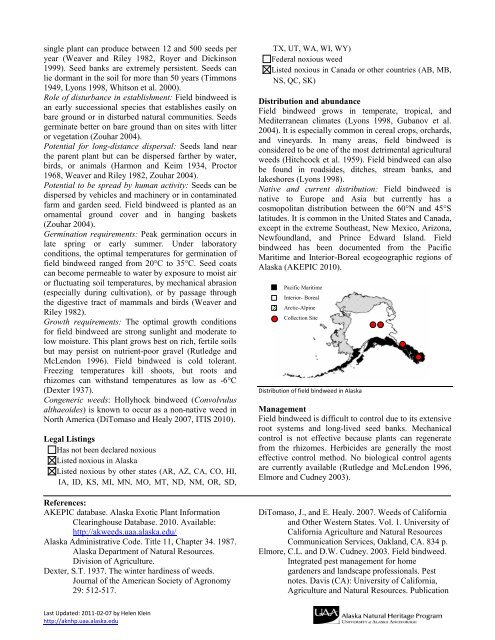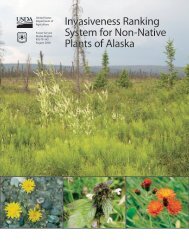field bindweed Convolvulus arvensis L.
field bindweed Convolvulus arvensis L.
field bindweed Convolvulus arvensis L.
You also want an ePaper? Increase the reach of your titles
YUMPU automatically turns print PDFs into web optimized ePapers that Google loves.
single plant can produce between 12 and 500 seeds peryear (Weaver and Riley 1982, Royer and Dickinson1999). Seed banks are extremely persistent. Seeds canlie dormant in the soil for more than 50 years (Timmons1949, Lyons 1998, Whitson et al. 2000).Role of disturbance in establishment: Field <strong>bindweed</strong> isan early successional species that establishes easily onbare ground or in disturbed natural communities. Seedsgerminate better on bare ground than on sites with litteror vegetation (Zouhar 2004).Potential for long-distance dispersal: Seeds land nearthe parent plant but can be dispersed farther by water,birds, or animals (Harmon and Keim 1934, Proctor1968, Weaver and Riley 1982, Zouhar 2004).Potential to be spread by human activity: Seeds can bedispersed by vehicles and machinery or in contaminatedfarm and garden seed. Field <strong>bindweed</strong> is planted as anornamental ground cover and in hanging baskets(Zouhar 2004).Germination requirements: Peak germination occurs inlate spring or early summer. Under laboratoryconditions, the optimal temperatures for germination of<strong>field</strong> <strong>bindweed</strong> ranged from 20°C to 35°C. Seed coatscan become permeable to water by exposure to moist airor fluctuating soil temperatures, by mechanical abrasion(especially during cultivation), or by passage throughthe digestive tract of mammals and birds (Weaver andRiley 1982).Growth requirements: The optimal growth conditionsfor <strong>field</strong> <strong>bindweed</strong> are strong sunlight and moderate tolow moisture. This plant grows best on rich, fertile soilsbut may persist on nutrient-poor gravel (Rutledge andMcLendon 1996). Field <strong>bindweed</strong> is cold tolerant.Freezing temperatures kill shoots, but roots andrhizomes can withstand temperatures as low as -6°C(Dexter 1937).Congeneric weeds: Hollyhock <strong>bindweed</strong> (<strong>Convolvulus</strong>althaeoides) is known to occur as a non-native weed inNorth America (DiTomaso and Healy 2007, ITIS 2010).Legal ListingsHas not been declared noxiousListed noxious in AlaskaListed noxious by other states (AR, AZ, CA, CO, HI,IA, ID, KS, MI, MN, MO, MT, ND, NM, OR, SD,References:AKEPIC database. Alaska Exotic Plant InformationClearinghouse Database. 2010. Available:http://akweeds.uaa.alaska.edu/Alaska Administrative Code. Title 11, Chapter 34. 1987.Alaska Department of Natural Resources.Division of Agriculture.Dexter, S.T. 1937. The winter hardiness of weeds.Journal of the American Society of Agronomy29: 512-517.TX, UT, WA, WI, WY)Federal noxious weedListed noxious in Canada or other countries (AB, MB,NS, QC, SK)Distribution and abundanceField <strong>bindweed</strong> grows in temperate, tropical, andMediterranean climates (Lyons 1998, Gubanov et al.2004). It is especially common in cereal crops, orchards,and vineyards. In many areas, <strong>field</strong> <strong>bindweed</strong> isconsidered to be one of the most detrimental agriculturalweeds (Hitchcock et al. 1959). Field <strong>bindweed</strong> can alsobe found in roadsides, ditches, stream banks, andlakeshores (Lyons 1998).Native and current distribution: Field <strong>bindweed</strong> isnative to Europe and Asia but currently has acosmopolitan distribution between the 60°N and 45°Slatitudes. It is common in the United States and Canada,except in the extreme Southeast, New Mexico, Arizona,Newfoundland, and Prince Edward Island. Field<strong>bindweed</strong> has been documented from the PacificMaritime and Interior-Boreal ecogeographic regions ofAlaska (AKEPIC 2010).Pacific MaritimeInterior- BorealArctic-AlpineCollection SiteDistribution of <strong>field</strong> <strong>bindweed</strong> in AlaskaManagementField <strong>bindweed</strong> is difficult to control due to its extensiveroot systems and long-lived seed banks. Mechanicalcontrol is not effective because plants can regeneratefrom the rhizomes. Herbicides are generally the mosteffective control method. No biological control agentsare currently available (Rutledge and McLendon 1996,Elmore and Cudney 2003).DiTomaso, J., and E. Healy. 2007. Weeds of Californiaand Other Western States. Vol. 1. University ofCalifornia Agriculture and Natural ResourcesCommunication Services, Oakland, CA. 834 p.Elmore, C.L. and D.W. Cudney. 2003. Field <strong>bindweed</strong>.Integrated pest management for homegardeners and landscape professionals. Pestnotes. Davis (CA): University of California,Agriculture and Natural Resources. PublicationLast Updated: 2011-02-07 by Helen Kleinhttp://aknhp.uaa.alaska.edu
















